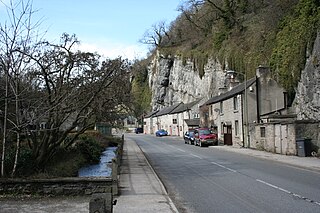Related Research Articles

The Great Plague of London, lasting from 1665 to 1666, was the last major epidemic of the bubonic plague to occur in England. It happened within the centuries-long Second Pandemic, a period of intermittent bubonic plague epidemics that originated in Central Asia in 1331, and included related diseases such as pneumonic plague and septicemic plague, which lasted until 1750.

Sir Alan Arthur Bates was an English actor who came to prominence in the 1960s, when he appeared in films ranging from the popular children's story Whistle Down the Wind to the "kitchen sink" drama A Kind of Loving.

Eyam is an English village and civil parish in the Derbyshire Dales that lies within the Peak District National Park. There is evidence of early occupation by Ancient Britons on the surrounding moors and lead was mined in the area by the Romans. A settlement was founded on the present site by Anglo-Saxons, when mining was continued and other industries later developed. However, Eyam’s main claim to fame is the story of how the village chose to go into isolation so as to prevent infection spreading after bubonic plague was discovered there in 1665.

Martin Shaw is an English stage, television, and film actor. He came to national recognition as Doyle in ITV crime-action television drama series The Professionals (1977–1983). Further notable television parts include the title roles in The Chief (1993–1995), Judge John Deed (2001–2007) and Inspector George Gently (2007–2017). He has also acted on stage and in film, and has narrated numerous audiobooks and presented various television series.
Gwen Taylor is an English actress who has appeared in many British television programmes. She is known for her roles as Amy Pearce in the sitcom Duty Free (1984–1986); Barbara Liversidge in the sitcom Barbara (1999–2003); Peggy Armstrong in the drama series Heartbeat (2005–2009), Anne Foster in the long-running ITV soap opera Coronation Street (2011–2012), and Vi Highway in BBC One soap opera EastEnders (2021–2023). She was nominated for the 1990 BAFTA TV Award for Best Actress for her role as Rita Simcock in the comedy series A Bit of a Do (1989). Her film appearances include Monty Python's Life of Brian (1979) and The Lady in the Van (2015).
Donald Victor Taylor was an English writer, director and producer, active across theatre, radio and television for over forty years. He is most noted for his television work, particularly his early 1960s collaborations with the playwright David Mercer, much of whose early work Taylor directed for the BBC.

Stoney Middleton is a village and civil parish in the Derbyshire Dales district of Derbyshire, England. It is in the White Peak area of the Peak District southeast of Eyam and northwest of Calver, on the A623 road at the foot of the limestone valley of Middleton Dale. The population at the 2011 Census was 470.

Sleuth is a 1970 play written by Anthony Shaffer. The Broadway production received the Tony Award for Best Play, and Anthony Quayle and Keith Baxter received the Drama Desk Award for Outstanding Performance. The play was adapted for feature films in 1972, 2007 and 2014.

Murray Melvin was an English actor. He was best known for his acting work with Joan Littlewood, Ken Russell and Stanley Kubrick. He was the author of two books: The Art of Theatre Workshop (2006) and The Theatre Royal, A History of the Building (2009).

Year of Wonders: A Novel of the Plague is a 2001 international bestselling historical fiction novel by Geraldine Brooks. It was chosen as both a New York Times and Washington Post Notable Book.

Eakring is a village and civil parish in the Newark and Sherwood district of Nottinghamshire, England. Its population at the 2011 census was 419, and this increased to 440 residents for the 2021 census. There was sizeable oil production there in the mid-20th century.
The Negro Ensemble Company (NEC) is a New York City-based theater company and workshop established in 1967 by playwright Douglas Turner Ward, producer-actor Robert Hooks, and theater manager Gerald S. Krone, with funding from the Ford Foundation. The company's focus on original works with themes based in the black experience with an international perspective created a canon of theatrical works and an audience for writers who came later, such as August Wilson, Suzan-Lori Parks, and others.

Ramlila is any dramatic folk re-enactment of the life of Rama according to the ancient Hindu epic Ramayana or secondary literature based on it such as the Ramcharitmanas. It particularly refers to the thousands of the Hindu god Rama-related dramatic plays and dance events, that are staged during the annual autumn festival of Navaratri in India. After the enactment of the legendary war between good and evil, the Ramlila celebrations climax in the Vijayadashami (Dussehra) night festivities where the giant grotesque effigies of evil such as of the rakshasa (demon) Ravana are burnt, typically with fireworks.

William Mompesson was a Church of England priest whose decisive action when his Derbyshire parish, Eyam, became infected with the plague in the 17th century averted more widespread catastrophe.
Events from the year 1665 in England.

Marathi theatre is theatre in the Marathi language, mostly originating or based in the state of Maharashtra in India, and elsewhere with Marathi diaspora. Starting in the middle of the 19th century, it flourished in the 1950s and 1960s. Today, it continues to have a marked presence in the State of Maharashtra with a loyal audience base, when most theatre in other parts of India have had tough time facing the onslaught of cinema and television. Its repertoire ranges from musicals, humorous social plays, farces, historical plays like 'Vedat Marathe Veer Daudale Saat' by Bashir Momin Kavathekar, to experimental plays and serious drama of the 1970s onwards, by Vijay Tendulkar, P. L. Deshpande, Mahesh Elkunchwar and Satish Alekar, which have influenced theatre throughout India. In the post-independence era, Bengali theatre, and Marathi theatre have been at the forefront of innovations and significant dramaturgy in Indian theatre.
Eyam is a civil parish in the Derbyshire Dales district of Derbyshire, England. The parish contains 55 listed buildings that are recorded in the National Heritage List for England. Of these, one is listed at Grade I, the highest of the three grades, two are at Grade II*, the middle grade, and the others are at Grade II, the lowest grade. The parish contains the village of Eyam and the surrounding countryside. The history of the village is notable because when the plague broke out in 1666, the village went into voluntary quarantine to prevent the disease from spreading outside. Some of the listed buildings are associated with this event, including cottages occupied by the victims of the disease, and their gravestones. Most of the other listed buildings are houses, cottages and farmhouses and associated structures. The other listed buildings include a church, a cross and tombs in the churchyard, the rectory, a well head, water troughs, a set of stocks, and the former engine house to a lead mine,

Mompesson's Well is a 17th-century grade II listed water well in Eyam, Derbyshire.

Thomas Stanley was an ejected puritan minister whose actions alongside Church of England priest William Mompesson when the Derbyshire parish, Eyam, became infected with the plague during the 17th century averted more widespread catastrophe.
Shorland (or Sherland)Adams (c. 1605 – 11 Apr 1664) was a Church of England priest whose outspoken support for the Royalists during the English Civil War garnished his reputation during his tenure in the parishes of Eyam and Treeton.
References
- ↑ Historical background BBC Local History - Derbyshire, Feb 2004
- ↑ ‘The Roses of Eyam’ at Maddog. June 2005
- 1 2 Taylor, Don; Speakman, Ray (1996). The Roses of Eyam. Heinemann. pp. Introduction. ISBN 0-435-23316-5.
- 1 2 IMDB details Information on the 1973 TV production.
- ↑ Hunt, Peter; Sheila, G; Bannister, Ray (1996). International Companion Encyclopedia of Children's Literature. Taylor & Francis. p. 218. ISBN 0-415-08856-9.
- ↑ Genealogical evidence of this Archived 2007-09-30 at the Wayback Machine William Mompesson of Eyam (1639-1709) at Genealogy UK and Ireland. Rosemary Lockie , March 2007